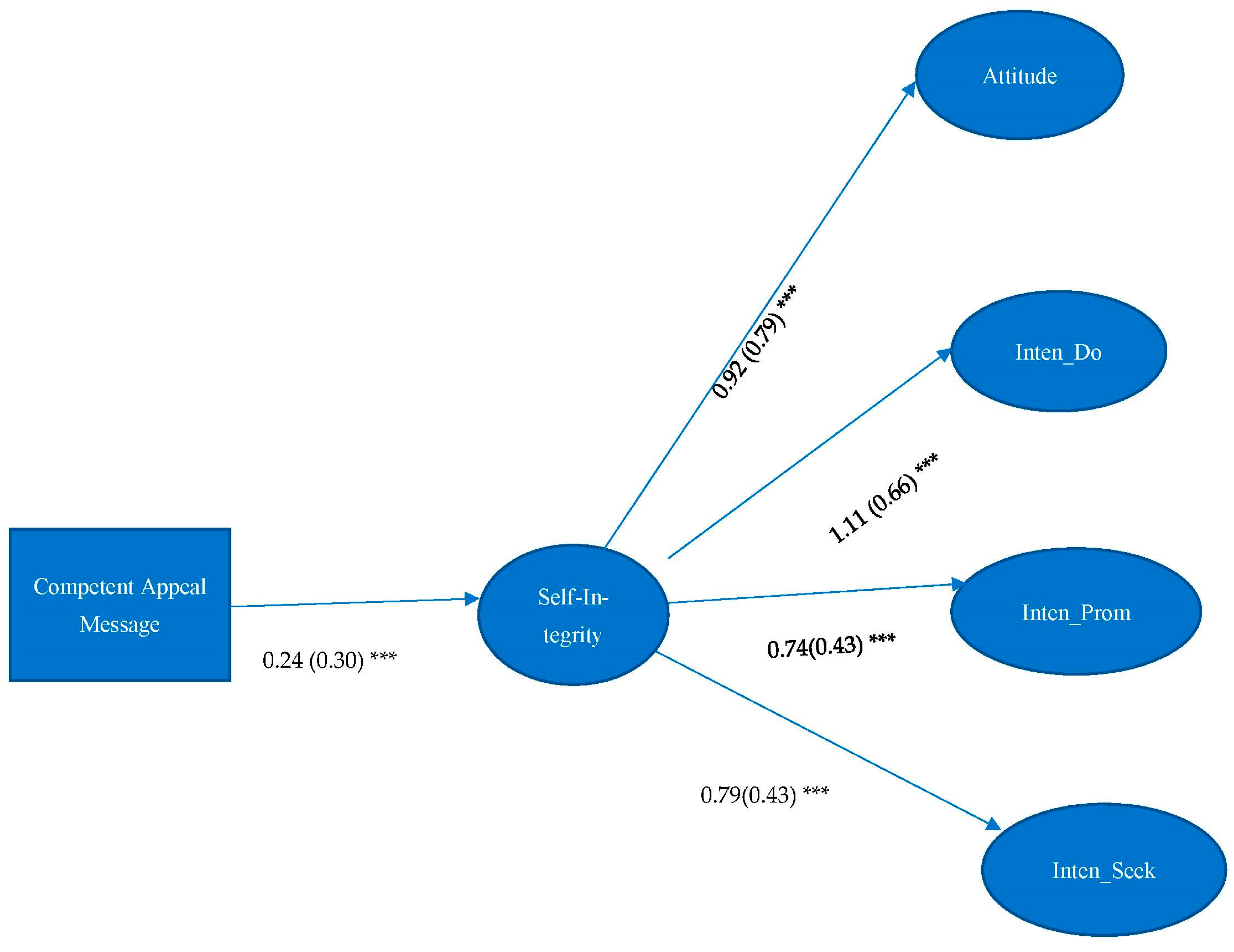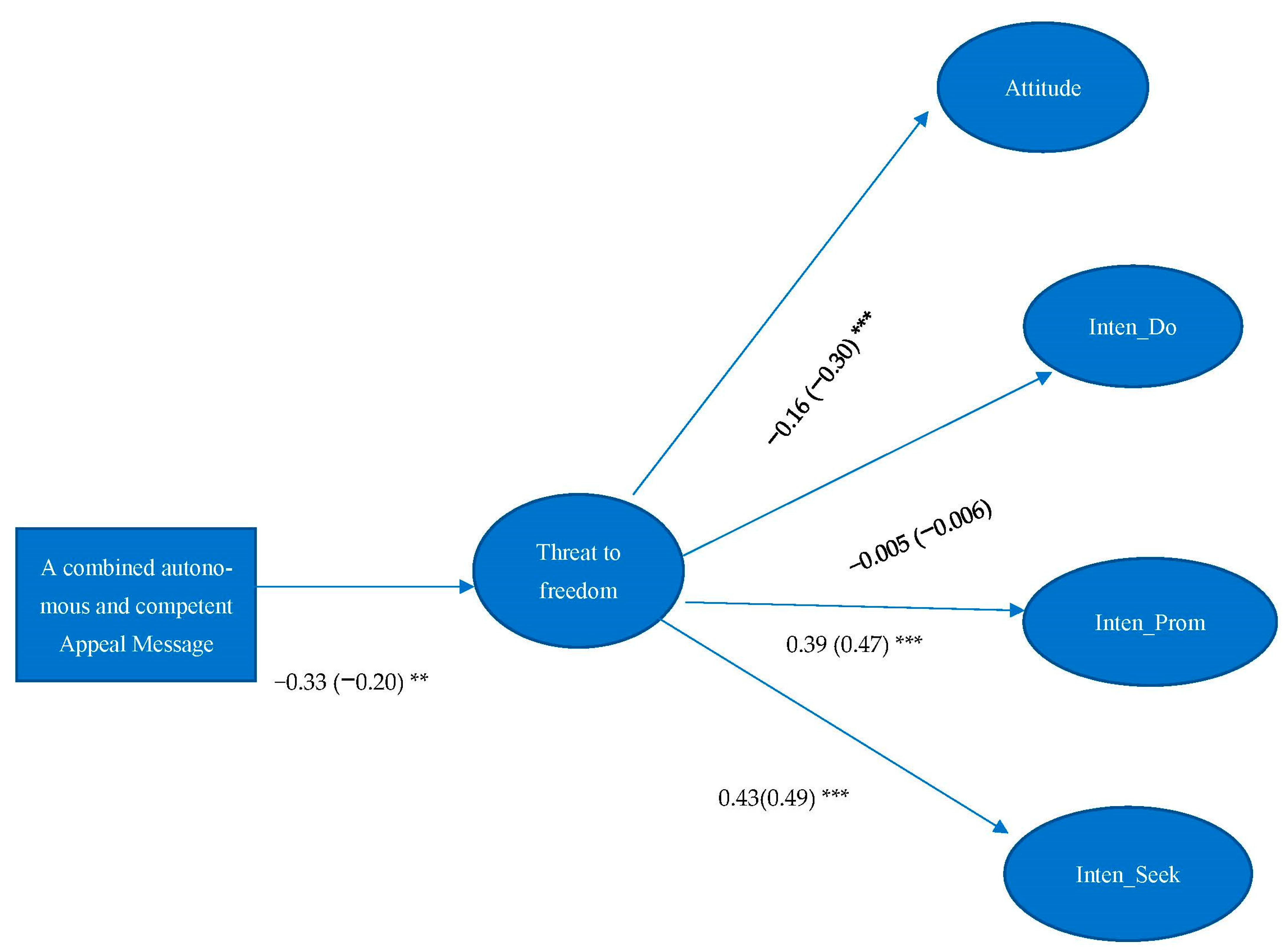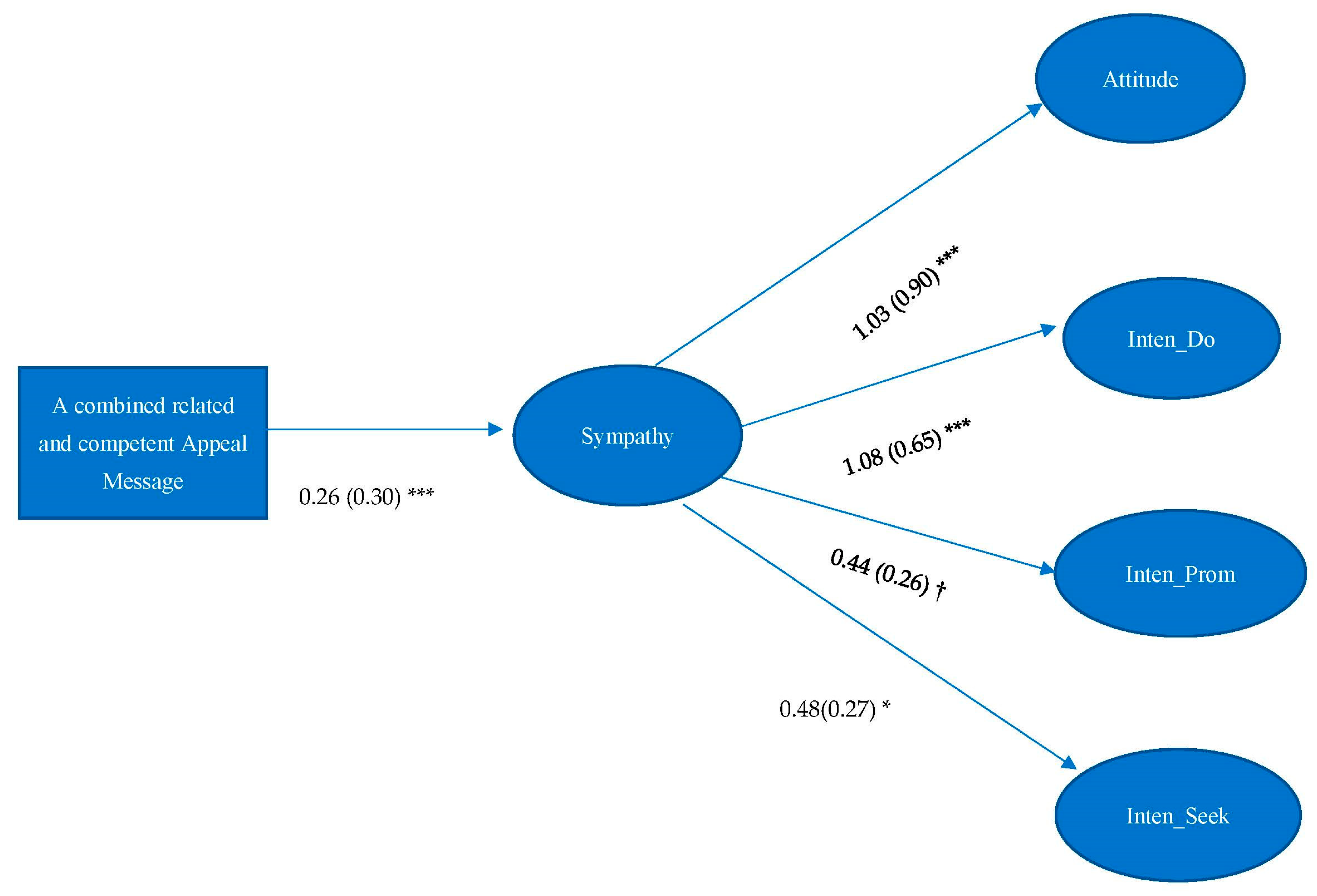Examining the Effect of Self-Determined Appeal Organ Donation Messages and Respective Underlying Mechanism
Abstract
:1. Introduction
2. Literature Review
2.1. Self-Determination Theory
2.2. Self-Integrity
2.3. Perceived Threat to Freedom
2.4. Sympathy
2.5. Pride
3. Method
3.1. Experimental Design and Procedure
3.2. Participants
3.3. Stimuli
3.4. Pretest
3.5. Measurement
4. Results
Hypotheses Testing
5. Discussion
6. Conclusions
Funding
Institutional Review Board Statement
Informed Consent Statement
Data Availability Statement
Conflicts of Interest
References
- UNOS. All-Time Records Again Set in 2021 for Organ Transplants, Organ Donation from Deceased Donors. 11 January 2022. Available online: https://unos.org/news/2021-all-time-records-organ-transplants-deceased-donor-donation/ (accessed on 11 January 2022).
- Latkin, C.A.; Knowlton, A.R. Social network assessments and interventions for health behavior change: A critical review. Behav. Med. 2015, 41, 90–97. [Google Scholar] [CrossRef] [PubMed]
- Silva, M.; Marques, M.; Teixeira, P. Testing theory in practice: The example of self-determination theory-based interventions. Eur. Health Psychol. 2014, 16, 171–180. [Google Scholar]
- Reinhart, A.M.; Marshall, H.M.; Feeley, T.H.; Tutzauer, F. The persuasive effects of message framing in organ donation: The mediating role of psychological reactance. Commun. Monogr. 2007, 74, 229–255. [Google Scholar] [CrossRef]
- Cohen, E.L.; Hoffner, C. Gifts of giving: The role of empathy and perceived benefits to others and self in young adults’ decisions to become organ donors. J. Health Psychol. 2012, 18, 128–138. [Google Scholar] [CrossRef] [PubMed]
- Moorlock, G.; Ives, J.; Draper, H. Altruism in organ donation: An unnecessary requirement? J. Med. Ethics 2014, 40, 134–138. [Google Scholar] [CrossRef]
- Kong, S.; Lee, Y. How perceived similarity moderates sympathy and pride appeal in organ donation messages. Transplant. Proc. 2021, 53, 2105–2111. [Google Scholar] [CrossRef]
- Deci, E.L.; Ryan, R.M. The general causality orientations scale: Self-determination in personality. J. Res. Personal. 1985, 19, 109–134. [Google Scholar] [CrossRef]
- MCQueen, A.; Klein, W.M. Experimental manipulations of self-affirmation: A systematic review. Self Identity 2006, 5, 289–354. [Google Scholar] [CrossRef]
- Napper, L.; Harris, P.R.; Epton, T. Developing and testing a self-affirmation manipulation. Self Identity 2009, 8, 45–62. [Google Scholar] [CrossRef]
- Dillard, J.P.; Shen, L. On the nature of reactance and its role in persuasive health communication. Commun. Monogr. 2005, 72, 144–168. [Google Scholar] [CrossRef]
- Deci, E.L.; Ryan, R.M. The “What” and “Why” of goal pursuits: Human needs and the self-determination of behavior. Psychol. Inq. 2000, 11, 227–268. [Google Scholar] [CrossRef]
- Ryan, R.M.; Connell, J.P. Perceived locus of causality and internalization: Examining reasons for acting in two domains. J. Personal. Soc. Psychol. 1989, 57, 749–761. [Google Scholar] [CrossRef]
- Pavey, L.; Greitemeyer, T.; Sparks, P. “I help because I want to, not because you tell me to”: Empathy increases autonomously motivated helping. Personal. Soc. Psychol. Bull. 2012, 38, 681–689. [Google Scholar] [CrossRef]
- Weinstein, N.; Ryan, R.M. When helping helps: Autonomous motivation for prosocial behavior and its influence on well-being for the helper and recipient. J. Personal. Soc. Psychol. 2010, 98, 222–244. [Google Scholar] [CrossRef]
- Pavey, L.; Greitemeyer, T.; Sparks, P. Highlighting relatedness promotes prosocial motives and behavior. Personal. Soc. Psychol. Bull. 2011, 37, 905–917. [Google Scholar] [CrossRef]
- Baumeister, R.F.; Leary, M.R. The need to belong: Desire for interpersonal attachments as a fundamental human motivation. Psychol. Bull. 1995, 117, 497–529. [Google Scholar] [CrossRef]
- Caprara, G.V.; Steca, P. Affective and social self—Regulatory efficacy beliefs as determinants of positive thinking and happiness. Eur. Psychol. 2005, 10, 275–286. [Google Scholar] [CrossRef]
- Moller, A.C.; Deci, E.L.; Elliot, A.J. Person-level relatedness and the incremental value of relating. Personal. Soc. Psychol. Bull. 2010, 36, 754–767. [Google Scholar] [CrossRef]
- Bachmann, J.M.; Goggins, K.M.; Nwosu, S.K.; Schildcrout, J.S.; Kripalani, S.; Wallston, K.A. Perceived health competence predicts health behavior and health-related quality of life in patients with cardiovascular disease. Patient Educ. Couns. 2016, 99, 2071–2079. [Google Scholar] [CrossRef]
- Chien, Y.; Chang, W. Effects of message framing and exemplars on promoting organ donation. Psychol. Rep. 2015, 117, 692–702. [Google Scholar] [CrossRef]
- Sun, H. A study on the development of public campaign messages for organ donation promotion in Korea. Health Promot. Int. 2014, 30, 903–918. [Google Scholar] [CrossRef] [PubMed] [Green Version]
- Steele, C.M. The Psychology of Self-Affirmation: Sustaining the Integrity of the Self. In Advances in Experimental Social Psychology; Berkowitz, L., Ed.; Academic Press: New York, NY, USA, 1988; Volume 21, pp. 261–302. [Google Scholar]
- Sherman, D.K.; Cohen, G.L. The psychology of self-defense: Self-affirmation theory. Adv. Exp. Soc. Psychol. 2006, 38, 183–242. [Google Scholar] [CrossRef]
- Hirschberger, G.; Ein-Dor, T.; Almakias, S. The self-protective altruist: Terror management and the ambivalent nature of prosocial behavior. Personal. Soc. Psychol. Bull. 2008, 34, 666–678. [Google Scholar] [CrossRef] [PubMed]
- Brehm, J.W. A Theory of Psychological Reactance; Academic Press: Cambridge, MA, USA, 1966. [Google Scholar]
- Brehm, S.S. Psychological reactance and the attractiveness of unobtainable objects: Sex differences in children’s responses to an elimination of freedom. Sex Roles 1981, 7, 937–949. [Google Scholar] [CrossRef]
- Smit, E.S.; Zeidler, C.; Resnicow, K.; De Vries, H. Identifying the most autonomy-supportive message frame in digital health communication: A 2x2 between-subjects experiment. J. Med. Internet Res. 2019, 21, e14074. [Google Scholar] [CrossRef]
- Smith, S.W.; Cornacchione, J.J.; Morash, M.; Kashy, D.; Cobbina, J. Communication style as an antecedent to reactance, self-efficacy, and restoration of freedom for drug- and alcohol-involved women on probation and parole. J. Health Commun. 2016, 21, 504–511. [Google Scholar] [CrossRef]
- Batson, C.D.; Turk, C.L.; Shaw, L.L.; Klein, T.R. Information function of empathic emotion: Learning that we value the other’s welfare. J. Personal. Soc. Psychol. 1995, 68, 300–313. [Google Scholar] [CrossRef]
- Leach, C.W.; Snider, N.; Iyer, A. “Poisoning the Consciences of the Fortunate”: The Experience of Relative Advantage and Support for Social Equality. In Relative Deprivation: Specification, Development, and Integration; Walker, I., Smith, H.J., Eds.; Cambridge University Press: New York, NY, USA, 2002; pp. 136–163. [Google Scholar]
- Dovidio, J.F.; Gaertner, S.L.; Validzic, A.; Matoka, K.; Johnson, B.; Frazier, S. Extending the benefits of recategorization: Evaluations, self-disclosure, and helping. J. Exp. Soc. Psychol. 1997, 33, 401–420. [Google Scholar] [CrossRef]
- Hornstein, H.A. Cruelty and Kindness: A New Look at Aggression and Altruism; Prentice-Hall: Englewood Cliffs, NJ, USA, 1976. [Google Scholar]
- Loewenstein, G.; Small, D.A. The scarecrow and the tin man: The vicissitudes of human sympathy and caring. Rev. Gen. Psychol. 2007, 11, 112–126. [Google Scholar] [CrossRef]
- Small, D.; Loewenstein, G. Helping a victim or helping the victim: Altruism and identifiability. J. Risk Uncertain. 2003, 26, 5–16. [Google Scholar] [CrossRef]
- Dijker, A.J.; Nelissen, R.M.; Stijnen, M.M. Framing posthumous organ donation in terms of reciprocity: What are the emotional consequences? Basic Appl. Soc. Psychol. 2013, 35, 256–264. [Google Scholar] [CrossRef]
- Massi Lindsey, L.L.; Ah Yun, K. The relationship between narrative content variation, affective and cognitive reactions, and a person’s willingness to sign an organ donor card. Commun. Res. Rep. 2005, 22, 253–263. [Google Scholar] [CrossRef]
- Kong, S. How sympathy and fear mediate the interplay between benefit and scarcity appeal organ donation messages. J. Commun. Healthc. 2022, 1–11. [Google Scholar] [CrossRef]
- Tracy, J.L.; Robins, R.W. The psychological structure of pride: A tale of two facets. J. Personal. Soc. Psychol. 2007, 92, 506–525. [Google Scholar] [CrossRef]
- Haidt, J. The emotional dog and its rational tail: A social intuitionist approach to moral judgment. Psychol. Rev. 2001, 108, 814–834. [Google Scholar] [CrossRef]
- Weiner, B. An attributional theory of achievement motivation and emotion. Psychol. Rev. 1985, 92, 548–573. [Google Scholar] [CrossRef] [PubMed]
- Feeley, T.H.; Servoss, T.J. Examining college students’ intentions to become organ donors. J. Health Commun. 2005, 10, 237–249. [Google Scholar] [CrossRef]
- Wang, X.; Zhao, X. The mediating role of temporal considerations on the effects of self-affirmation on responses to organ donation messages. Health Commun. 2016, 33, 148–155. [Google Scholar] [CrossRef] [PubMed]
- Chun, J.W.; Lee, M.J. Increasing individuals’ involvement and WOM intention on social networking sites: Content matters! Comput. Hum. Behav. 2016, 60, 223–232. [Google Scholar] [CrossRef]
- Sherman, D.K.; Cohen, G.L.; Nelson, L.D.; Nussbaum, A.D.; Bunyan, D.P.; Garcia, J. Affirmed yet unaware: Exploring the role of awareness in the process of self-affirmation. J. Personal. Soc. Psychol. 2009, 97, 745–764. [Google Scholar] [CrossRef]
- Vossen, H.G.; Piotrowski, J.T.; Valkenburg, P.M. Development of the adolescent measure of empathy and sympathy (AMES). Personal. Individ. Differ. 2015, 74, 66–71. [Google Scholar] [CrossRef]
- Krettenauer, T.; Casey, V. Moral identity development and positive moral emotions: Differences involving authentic and hubristic pride. Identity 2015, 15, 173–187. [Google Scholar] [CrossRef]
- Hu, L.; Bentler, P.M. Cutoff criteria for fit indexes in covariance structure analysis: Conventional criteria versus new alternatives. Struct. Equ. Model. A Multidiscip. J. 1999, 6, 1–55. [Google Scholar] [CrossRef]
- Kline, R.B. Principle and Practice of Structural Equation Modeling; The Guilford Press: New York, NY, USA, 2005; pp. 1–385. [Google Scholar]
- Bagozzi, R.P.; Yi, Y.; Phillips, L.W. Assessing construct validity in organizational research. Adm. Sci. Q. 1991, 36, 421. [Google Scholar] [CrossRef]
- Greenberg, J.; Schimel, J.; Martens, A.; Solomon, S.; Pyszcznyski, T. Sympathy for the devil: Evidence that reminding Whites of their mortality promotes more favorable reactions to White racists. Motiv. Emot. 2001, 25, 113–133. [Google Scholar] [CrossRef]
- Klein, W.M.; Harris, P.R. Self-affirmation enhances attentional bias toward threatening components of a persuasive message. Psychol. Sci. 2009, 20, 1463–1467. [Google Scholar] [CrossRef]
- Van Koningsbruggen, G.M.; Das, E.; Roskos-Ewoldsen, D.R. How self-affirmation reduces defensive processing of threatening health information: Evidence at the implicit level. Health Psychol. 2009, 28, 563–568. [Google Scholar] [CrossRef]
- Quick, B.L.; Kam, J.A.; Morgan, S.E.; Montero Liberona, C.A.; Smith, R.A. Prospect theory, discrete emotions, and freedom threats: An extension of psychological reactance theory. J. Commun. 2014, 65, 40–61. [Google Scholar] [CrossRef]
- VanderWeele, T.; Vansteelandt, S. Mediation analysis with multiple mediators. Epidemiol. Methods 2014, 2, 95–115. [Google Scholar] [CrossRef]
- Greenberg, J.; Pyszczynski, T.; Solomon, S. The Causes and Consequences of a Need for Self-Esteem: A Terror Management Theory. In Public Self and Private Self; Springer Series in Social Psychology Book Series (SSSOC); Springer: Berlin/Heidelberg, Germany, 1986; pp. 189–212. [Google Scholar] [CrossRef]
- Jain, P.; Ellithorpe, M.E. Mortality salience influences attitudes and information-seeking behavior related to organ donation. J. Commun. Healthc. 2016, 9, 126–134. [Google Scholar] [CrossRef]
- Boulware, L.E.; Troll, M.U.; Wang, N.Y.; Powe, N.R. Public attitudes toward incentives for organ donation: A national study of different racial/Ethnic and income groups. Am. J. Transplant. 2006, 6, 2774–2785. [Google Scholar] [CrossRef]
- Kreuter, M.W.; Wray, R.J. Tailored and targeted health communication: Strategies for enhancing information relevance. Am. J. Health Behav. 2003, 27, 227–232. [Google Scholar] [CrossRef]
- Zhang, C.; Van Gorp, P.; Derksen, M.; Nuijten, R.; IJsselsteijn, W.A.; Zanutto, A.; Melillo, F.; Pratola, R. Promoting occupational health through Gamification and E-coaching: A 5-Month user engagement study. Int. J. Environ. Res. Public Health 2021, 18, 2823. [Google Scholar] [CrossRef]
- Morgan, S.; Miller, J. Communicating about gifts of life: The effect of knowledge, attitudes, and altruism on behavior and behavioral intentions regarding organ donation. J. Appl. Commun. Res. 2002, 30, 163–178. [Google Scholar] [CrossRef]
- Wakefield, C.; Watts, K.; Homewood, J.; Meiser, B.; Siminoff, L. Attitudes toward organ donation and donor behavior: A review of the international literature. Prog. Transplant. 2010, 20, 380–391. [Google Scholar] [CrossRef]
- Bresnahan, M.J.; Guan, X.; Smith, S.W.; Wang, X.; Edmundson, J.Z. Cultures of the soul: Spiritual beliefs about organ donation in China and the United States. Chin. J. Commun. 2010, 3, 133–146. [Google Scholar] [CrossRef]





Publisher’s Note: MDPI stays neutral with regard to jurisdictional claims in published maps and institutional affiliations. |
© 2022 by the author. Licensee MDPI, Basel, Switzerland. This article is an open access article distributed under the terms and conditions of the Creative Commons Attribution (CC BY) license (https://creativecommons.org/licenses/by/4.0/).
Share and Cite
Kong, S. Examining the Effect of Self-Determined Appeal Organ Donation Messages and Respective Underlying Mechanism. Int. J. Environ. Res. Public Health 2022, 19, 10619. https://doi.org/10.3390/ijerph191710619
Kong S. Examining the Effect of Self-Determined Appeal Organ Donation Messages and Respective Underlying Mechanism. International Journal of Environmental Research and Public Health. 2022; 19(17):10619. https://doi.org/10.3390/ijerph191710619
Chicago/Turabian StyleKong, Sining. 2022. "Examining the Effect of Self-Determined Appeal Organ Donation Messages and Respective Underlying Mechanism" International Journal of Environmental Research and Public Health 19, no. 17: 10619. https://doi.org/10.3390/ijerph191710619
APA StyleKong, S. (2022). Examining the Effect of Self-Determined Appeal Organ Donation Messages and Respective Underlying Mechanism. International Journal of Environmental Research and Public Health, 19(17), 10619. https://doi.org/10.3390/ijerph191710619




